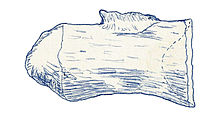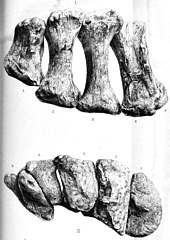Macrurosaurus
| Macrurosaurus Temporal range: lateAlbian,
| |
|---|---|

| |
| Vertebra ofM. semnus | |
| Scientific classification | |
| Domain: | Eukaryota |
| Kingdom: | Animalia |
| Phylum: | Chordata |
| Clade: | Dinosauria |
| Clade: | Saurischia |
| Clade: | †Sauropodomorpha |
| Clade: | †Sauropoda |
| Clade: | †Macronaria |
| Clade: | †Titanosauriformes |
| Genus: | †Macrurosaurus Seeley,1869 |
| Type species | |
| †Macrurosaurus semnus Seeley, 1869
| |
| Other species | |
| |
| Synonyms | |
| |
Macrurosaurus(meaning "large-tailed lizard" ) is the name given to agenusofdinosaurfrom theEarly Cretaceous.It was atitanosauriformwhich lived in what is nowEngland.The type species,M. semnus,was named in 1876.[1]A second species,M. platypus,may also exist.[2][3]
History
[edit]The genusMacrurosauruswas named byHarry Govier Seeleyin 1869 in his index of fossils from theCambridge Greensand.[4]In 1876 Seeley more thoroughly described thetype species,Macrurosaurus semnus,making the name valid.[1]The generic name is derived from Greekmakros,"large", andoura,"tail". Thespecific nameis derived from Greeksemnos,"stately" or "impressive". A second species,M. platypus,from theChalk GroupofEngland,may also exist.[2]Seeley in 1869 named it as a species of theankylosauridAcanthopholisbutFriedrich von Huenenamed it as a second species ofMacrurosaurusin 1956.[3]It is known from the specimenCAMSM B55454-55461.[5]In 1999Xabier Pereda-SuperbiolaandPaul M. Barrettreviewed allAcanthopholismaterial. They concluded that all species werenomina dubiawhose syntype specimens were composites of non-diagnostic ankylosaur and ornithopod remains. For example, the metatarsals included in the syntype series ofAcanthopholis platypusare from a sauropod, but the remaining syntypes are not.[6]

TheholotypeofMacrurosaurus,SM B55630,consists of two series of caudal vertebrae found around 1864 nearCambridge, Englandin the Cambridge Greensand, strata themselves deposited during theCenomanianbut containingreworked fossilmaterial dating perhaps from around the lateAlbian.[7]The first was acquired by theWoodwardian Museumfrom William Farren who had it dug up atColdhams CommonnearBarnwell.This series is made up of 25 proximal vertebrae. The second was found by Reverend W. Stokes-Shaw at a slightly more western location nearBarton.It contained fifteen smaller distal vertebrae, from the tail end. Seeley, acting on the presumption that both finds belonged to the same species if not individual, combined the two series into one tail of about 4.5 metres length.
Other fragmentary fossils fromEngland(Acanthopholisplatypus),[2]FranceandArgentinahave later been referred toMacrurosaurus[8]but the identity is today doubted.[2]
A 2022 review consideredMacrurosaurusto be an indeterminate macronarian, while "Acanthopholis"platypuswas treated as indeterminate within Eusauropoda or Neosauropoda.[9]
Description
[edit]Macrurosauruswas by Seeley himself estimated to be about ten metres long. Often a length of around twelve metres (40 ft) is indicated in the popular literature. Thevertebraein front areprocoelous,meaning that the vertebral centra are hollow at the front end and convex at the back. Those behind areamphicoelous:hollow at both ends. Seeley assumed that the full count of tail vertebrae would have been about fifty.
Classification
[edit]Macrurosauruswas by Seeley assigned to theDinosauria.Richard Lydekkerin 1888 understood it belonged to theSauropoda.[10]In 1929Friedrich von Huenereferred it to theTitanosauridae.[11]In recent years however, it has been commonly concluded that the species cannot be further determined than a more generalTitanosauriformes.Also it is today often seen as anomen dubium.
References
[edit]- ^abH.G. Seeley, 1876, "OnMacrurosaurus semnus(Seeley), a long tailed animal with procoelous vertebrae from the Cambridge Upper Greensand, preserved in the Woodwardian Museum of the University of Cambridge ",Quarterly Journal of the Geological Society of London32:440-444doi:10.1144/GSL.JGS.1876.032.01-04.50
- ^abcdSeeley, H.G. (1879)."On the Dinosauria of the Cambridge Greensand".Quarterly Journal of the Geological Society.35(1–4): 591–636.doi:10.1144/GSL.JGS.1879.035.01-04.42.ISSN0370-291X.S2CID129277596.
- ^abvon Huene, F. (1956) "Palaeontologie und Phylogenie der niederen Tetrapoden"
- ^Seeley, Harry Govier (1869)."Index to the fossil remains of Aves, Ornithosauria, and Reptilia, from the Secondary System of Strata, arranged in the Woodwardian Museum of the University of Cambridge".Annals and Magazine of Natural History.5(27): 1–143.doi:10.1080/00222937008696143.ISSN0374-5481.
- ^Seeley, H.G. (1871)."XXXVII.— On Acanthopholis platypus (Seeley), a Pachypod from the Cambridge Upper Greensand".Annals and Magazine of Natural History.8(47): 305–318.doi:10.1080/00222937108696494.ISSN0374-5481.
- ^Superbiola, X.P.; Barrett, P.M. (1999). "A systematic review of ankylosaurian dinosaur remains from the Albian-Cenomanian of England".Special Papers in Palaeontology.60:177–208.
- ^Unwin, D.M. (2003). "On the phylogeny and evolutionary history of pterosaurs". In Buffetaut, Eric; Mazin Jean-Michel (eds.).Evolution and Palaeobiology of Pterosaurs.Geological Society Special Publication217.London: Geological Society. pp. 139–190.ISBN1-86239-143-2.
- ^F. v. Huene. 1927. Contribución a la paleogeografía de Sud América [Contribution to the paleogeography of South America]. Boletín de la Academia Nacional de Ciencias de la República Argentina 30:231-294
- ^Poropat, S.F.; Frauenfelder, T.G.; Mannion, P.D.; Rigby, S.L.; Pentland, A.H.; Sloan, T.; Elliott, D.A. (2022)."Sauropod dinosaur teeth from the lower Upper Cretaceous Winton Formation of Queensland, Australia and the global record of early titanosauriforms".Royal Society Open Science.9(7): 220381.Bibcode:2022RSOS....920381P.doi:10.1098/rsos.220381.PMC9277269.PMID35845848.
- ^R. Lydekker. 1888. Catalogue of the Fossil Reptilia and Amphibia in the British Museum (Natural History). Part I. Containing the Orders Ornithosauria, Crocodilia, Dinosauria, Squamata, Rhynchocephalia, and Proterosauria. British Museum (Natural History), London 1-309
- ^F. v. Huene, 1929, "Los sauriquios y ornitisquios del Cretáceo argentino",Anales del Museo de La Plata,serie 2 3: 1-196












